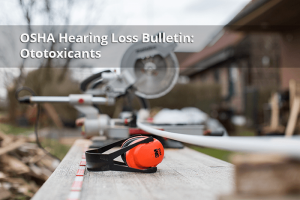OSHA Hearing Loss Bulletin Discusses Ototoxicants
Every worker understands the dangers, or at least the discomfort, of loud noises on a job site. Twenty-two million workers are exposed to potentially damaging noises every year, however, some of them also face a silent threat to their hearing. Certain chemicals, known as ototoxicants, can cause hearing loss regardless of noise exposure
(Related Article: Listen Up: Occupational Hearing Loss is Still a Problem)
Substances that contain ototoxicants include some pesticides, solvents, and pharmaceuticals that many workers are exposed to every day. OSHA recently released a new safety bulletin that lists the hazardous chemicals and warns about the risks of exposure. While prolonged exposure to loud sounds can kill nerve endings, these chemicals can negatively affect how the ear functions and can not only cause hearing damage, but loss of balance as well.
Negative Effects of Ototoxicants on Hearing
Ototoxicants can cause the most significant damage when workers are exposed to them while also working around high levels of noise. This combination can cause hearing loss that is either temporary or permanent, depending on several factors: the level of noise, the chemical level, and the duration of exposure.
(Related Article: What to Know About Occupational Hearing Safety)
Exposure to these harmful substances can occur through inhalation, ingestion, or skin absorption. Signs of chemical hearing damage include:
- Difficulty in distinguishing voices from background noise
- Sound distortion
- An inability to note time gaps between sounds
- Inability to recognize where sound is coming from
- Loss of balance
Hearing loss can be especially dangerous to those on a construction or jobsite who may be unable to hear a potential warning signal.
Which Industries are at Highest Risk?
Industries where workers may be at risk of ototoxicants include agriculture, construction, manufacturing, mining, and utilities. OSHA noted that the following manufacturing subsectors may be at a higher risk of these chemicals:
- Fabricated metal
- Machinery
- Leather and Allied Product
- Textile and Apparel
- Petroleum
- Paper
- Chemical (including Paint)
- Plastics
- Furniture and Related Product
- Transportation Equipment (e.g. Ship and Boat Building)
- Electrical Equipment, Appliance and Component (e.g., Batteries)
- Solar Cell
Controlling Noise Exposure at Work
The best way to control exposure to ototoxicants is to find a replacement to these potentially harmful substances. If this is not possible, using engineering controls and ventilation is also a recommended method.
Employers are responsible for assessing and determining the right PPE for their workers. Since these substances can be inhaled or absorbed, respiratory and hand protection requirements may apply. Chemical-protective gloves, arm sleeves, and aprons are common ways to reduce exposure to the skin.
These chemicals are why it’s still important for workers to have regular audiometric testing, regardless of noise exposure. No matter what the cause of the damage is — chemical or noise related — these tests can determine if your workers are experiencing hearing loss.
Worksite Medical offers on-site testing, including audiometric testing with Benson audiometers that are equipped with automatic retesting technology. Our mobile medical units can save time and help you stay compliant. Give us a call at 1-844-OCCUMED or visit us online to learn more and schedule an appointment.
Schedule Your Medical Surveillance Testing Today!
Schedule Your Medical Surveillance Silica Testing Today!





